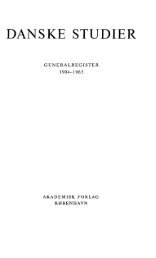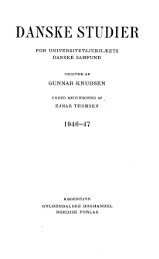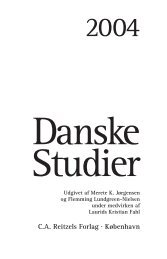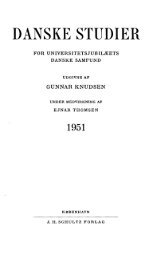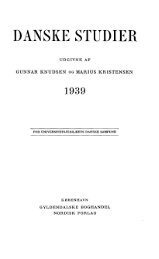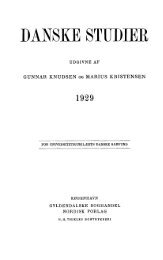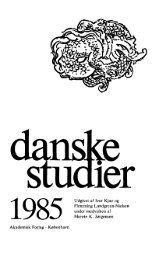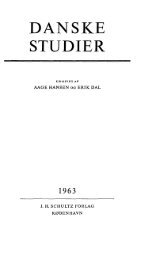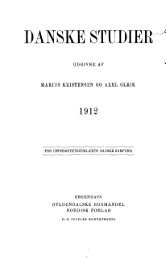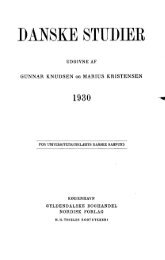1982 Udgivet af Iver Kjær og Flemming Lundgreen ... - Danske Studier
1982 Udgivet af Iver Kjær og Flemming Lundgreen ... - Danske Studier
1982 Udgivet af Iver Kjær og Flemming Lundgreen ... - Danske Studier
You also want an ePaper? Increase the reach of your titles
YUMPU automatically turns print PDFs into web optimized ePapers that Google loves.
Kierkegaards Literary Production by Quarterly Rates • 29<br />
Overall totals are given in detail in Table 1 and indicated in Fig. 5.<br />
In the latter particularly one sees the effects of adding the various<br />
groups of the Pap to SV C adds a left tail. B supplements SV particularly<br />
in 1846 (though the first quarter is still low); it also increases<br />
the quantity produced in 1855. The A group makes three substantial<br />
alterations; it tends to fiatten the peak of the central curve, moves it<br />
more to the right, and greatly increases the upturn at the end. In faet,<br />
this overall result may be seen in a variety of ways: as a more or less<br />
even curve peaking in 1844-47; as a bi-modal curve peaking in each<br />
of these years; or, most probably, as three separate curves spanning<br />
the years 1834-39, 1840-53, and 1853-55, respectively. In any event,<br />
and this is beyond any such interpretation, this chart shows three<br />
distinct peaks all with surprisingly similar values: the fourth quarter<br />
of 1844, the third quarter of 1847, and the fourth quarter of 1854.<br />
These are, without doubt, his three most productive quarters. Such,<br />
in any event, is the matter in grossest outline.<br />
Kierkegaard's diary contains numerous comments upon his<br />
authorship, the difficulties of being a writer, the condition of his<br />
body and, especially, his mind, its influences upon his work, etc.<br />
From this vast store almost everyone will have at least one remark<br />
against which he will wish to check these facts. It may therefore be<br />
salutory to refer to one such comment which seems almost totally at<br />
odds with this report. In this entry, 12 written some days <strong>af</strong>ter the<br />
event, Kierkegaard describes his experiences during and immediately<br />
following the preaching of Guds Uforanderlighed in Citadellets<br />
Kirke on May 18th, 1851. In it he complains about the pain involved<br />
in such physical exertion and writes that on the following day he was<br />
utterly exhausted and there<strong>af</strong>ter suffered terribly. Indeed, one gets<br />
the impression that he was perhaps unable to write a word for the<br />
next month or two. In faet, it seems doubtful that even this experience<br />
had any effect on his actual output; certainly it is not descernible<br />
in either our individual or overall totals.<br />
Hopefully other Kierkegaard scholars will find these data useful in<br />
their own work but we conclude with the mere mention of one important<br />
matter to which they would seem particularly relevant. As<br />
said at the outset, Kierkegaard was essentially (and perhaps compulsively)<br />
a writer, a person driven to express himself in and through<br />
the written and perhaps printed word. Granted this, and given due<br />
caution, the present record can then be seen as at least a rough




